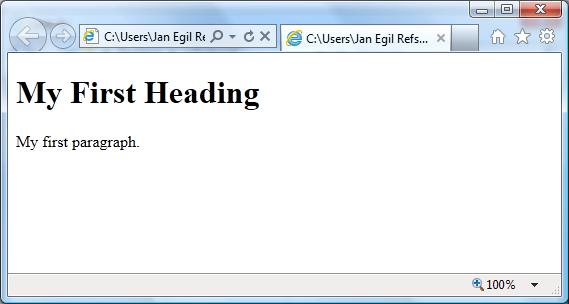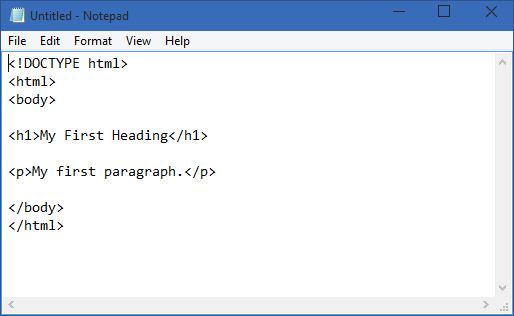What is HTML?
HTML is a language for describing web pages.- HTML stands for Hyper Text Markup Language
- HTML is a markup language
- A markup language is a set of markup tags
- The tags describe document content
- HTML documents contain HTML tags and plain text
- HTML documents are also called web pages
HTML Tags
HTML markup tags are usually called HTML tags- HTML tags are keywords (tag names) surrounded by angle brackets like <html>
- HTML tags normally come in pairs like <b> and </b>
- The first tag in a pair is the start tag, the second tag is the end tag
- The end tag is written like the start tag, with a forward slash before the tag name
- Start and end tags are also called opening tags and closing tags
<tagname>content</tagname>
HTML Elements
"HTML tags" and "HTML elements" are often used to describe the same thing.But strictly speaking, an HTML element is everything between the start tag and the end tag, including the tags:
HTML Element:
<p>This is a paragraph.</p>
Web Browsers
The purpose of a web browser (such as Google Chrome, Internet Explorer, Firefox, Safari) is to read HTML documents and display them as web pages. The browser does not display the HTML tags, but uses the tags to interpret the content of the page:
HTML Page Structure
Below is a visualization of an HTML page structure:
<html>
<body>
</html>
<h1>This a heading</h1>
<p>This is a paragraph.</p>
<p>This is another paragraph.</p>
</body>
HTML Versions
Since the early days of the web, there have been many versions of HTML:| Version | Year |
|---|---|
| HTML | 1991 |
| HTML+ | 1993 |
| HTML 2.0 | 1995 |
| HTML 3.2 | 1997 |
| HTML 4.01 | 1999 |
| XHTML 1.0 | 2000 |
| HTML5 | 2012 |
| XHTML5 | 2013 |
The <!DOCTYPE> Declaration
The <!DOCTYPE> declaration helps the browser to display a web page correctly.There are many different documents on the web, and a browser can only display an HTML page 100% correctly if it knows the HTML type and version used.
Common Declarations
HTML5
<!DOCTYPE html>
HTML 4.01
<!DOCTYPE HTML PUBLIC
"-//W3C//DTD HTML 4.01 Transitional//EN"
"http://www.w3.org/TR/html4/loose.dtd">
"http://www.w3.org/TR/html4/loose.dtd">
XHTML 1.0
<!DOCTYPE html PUBLIC "-//W3C//DTD XHTML 1.0 Transitional//EN"
"http://www.w3.org/TR/xhtml1/DTD/xhtml1-transitional.dtd">
"http://www.w3.org/TR/xhtml1/DTD/xhtml1-transitional.dtd">
Chapter 2:
Writing HTML Using Notepad or TextEdit
HTML can be edited by using a professional HTML editor like:- Adobe Dreamweaver
- Microsoft Expression Web
- CoffeeCup HTML Editor
Follow the 4 steps below to create your first web page with Notepad.
Step 1: Start Notepad
To start Notepad go to:Start
All Programs
Accessories
Notepad
Step 2: Edit Your HTML with Notepad
Type your HTML code into your Notepad:
Step 3: Save Your HTML
Select Save as.. in Notepad's file menu.When you save an HTML file, you can use either the .htm or the .html file extension. There is no difference, it is entirely up to you.
Save the file in a folder that is easy to remember, like w3schools.
Step 4: Run the HTML in Your Browser
Start your web browser and open your html file from the File, Open menu, or just browse the folder and double-click your HTML file.The result should look much like this:

Chapter 3:
HTML Basic - 4 Examples
Don't worry if the examples use tags you have not learned.
You will learn about them in the next chapters.
HTML Headings
HTML headings are defined with the <h1> to <h6> tags.Example
<h1>This is a heading</h1>
<h2>This is a heading</h2>
<h3>This is a heading</h3>
<h2>This is a heading</h2>
<h3>This is a heading</h3>
Try it yourself »
HTML Paragraphs
HTML paragraphs are defined with the <p> tag.HTML Links
HTML links are defined with the <a> tag.Note: The link address is specified in the href attribute.
(You will learn about attributes in a later chapter of this tutorial).
HTML Images
HTML images are defined with the <img> tag.Example
<img src="w3schools.jpg" width="104" height="142">
No comments:
Post a Comment